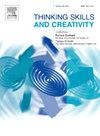Design knowledge scaffolds to facilitate students’ probabilistic thinking skills for solving classical probability problems: An exploratory study
IF 4.5
2区 教育学
Q1 Social Sciences
引用次数: 0
Abstract
Students encounter numerous difficulties in solving probability problems. Although there have been efforts to enhance students’ probabilistic thinking, most of these studies focused on extrinsic approaches such as contextual settings and visual representation aided by certain technologies. Few studies adopted an integrated perspective to design scaffolds from contextual, conceptual, and procedural dimensions and to examine their impact on students’ probabilistic thinking skills. This quasi-experimental study explored the effectiveness of integrated contextual-conceptual-procedural scaffolds of combinatorial knowledge to enhance middle school students’ performance in sample space and probability comparison tasks in compound experimental contexts. In this study, we divided four parallel seventh-grade classes from a school in Shanghai, China, involving 132 students into the experimental and control groups. Two classes in the experimental group received tailored instructional intervention, while two classes in the control group did not receive any additional intervention. The post-test revealed that the experimental group performed better than the control group on the sample space task. Still, the experimental group’s advantage on this task did not produce a chain effect. We propose three implications for improving textbook design and teaching practices by analyzing the potential reasons for the above findings.
设计知识脚手架,促进学生解决经典概率问题的概率思维技能:一项探索性研究
学生在解决概率问题时遇到许多困难。虽然已经有了提高学生概率思维的努力,但这些研究大多集中在外在方法上,如背景设置和某些技术辅助的视觉表现。很少有研究采用综合视角,从情境、概念和程序维度来设计支架,并检查它们对学生概率思维技能的影响。本研究旨在探讨组合知识的情境-概念-程序整合框架对提高中学生在复合实验情境下样本空间和概率比较任务中的表现的有效性。在本研究中,我们将中国上海一所学校的七年级学生分为四个平行班级,共132名学生分为实验组和对照组。实验组的两个班级接受了量身定制的教学干预,而对照组的两个班级没有接受任何额外的干预。后测结果显示,实验组在样本空间任务上的表现优于对照组。尽管如此,实验组在这项任务上的优势并没有产生连锁效应。通过分析上述发现的潜在原因,我们提出了改进教科书设计和教学实践的三点启示。
本文章由计算机程序翻译,如有差异,请以英文原文为准。
求助全文
约1分钟内获得全文
求助全文
来源期刊

Thinking Skills and Creativity
EDUCATION & EDUCATIONAL RESEARCH-
CiteScore
6.40
自引率
16.20%
发文量
172
审稿时长
76 days
期刊介绍:
Thinking Skills and Creativity is a new journal providing a peer-reviewed forum for communication and debate for the community of researchers interested in teaching for thinking and creativity. Papers may represent a variety of theoretical perspectives and methodological approaches and may relate to any age level in a diversity of settings: formal and informal, education and work-based.
 求助内容:
求助内容: 应助结果提醒方式:
应助结果提醒方式:


